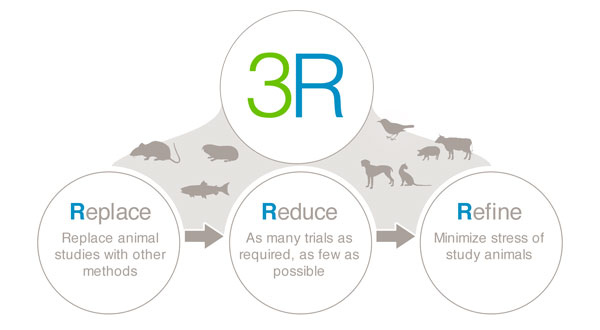Our Responsibility

As a global Life Science company we have a great responsibility for our customers, and for the animals used in our research. We fulfill this responsibility in a number of ways: We act in compliance with the Animal Welfare Law and the 3R principles keep us continuously on the search for ways to reduce, refine and replace animal studies. The newly offered 3R Award brings this idea into our daily work.
How Do We Fulfill Our Responsibility?
The so-called “3Rs” – Reduce, Refine, Replace – guide our research and development at Bayer. This means we continuously aim at:
- Reducing the number of animals used in studies: We use fewer animals per research program, but do not compromise on human safety.
- Refining study methods: Our studies are efficient because we make the best out of the information that we receive from animal research.
- Replacing animal studies with new methods: We develop and use non-animal techniques, such as human tissue, cell lines (in vitro), mathematical and computer (in silico) models.
When animal testing is unavoidable, we carefully design our experiments. All studies are performed with the highest concern for the health and comfort of the animals in our care. An expert is always appointed to deal with animal welfare matters. In Germany, it is the Animal Welfare Officer who takes on this important responsibility.
Although most of the animal tests are required by law, we continuously develop new technologies to reduce the number of animals used in studies and improve their well-being.

Reducing the Number of Research Animals by Means of Small Animal Imaging
Small animal imaging allows us less invasive testing while nonetheless providing meaningful scientific results. One way this method is used is to test the effects of a new active ingredient at different time points after administration. In the past, a group of study animals was used for each test time point (i.e. four groups for four time points). The effects could only be assessed after euthanizing the animals. Small animal imaging makes it possible to use just one group that can be continuously monitored, and thus can supply more data while using many fewer animals.
Our scientists are actively developing further small animal imaging procedures, such as microcomputer tomography (CT), magnetic resonance imaging (MRI) and micro ultrasound. In 2006, a research group at the Pharmaceuticals Division of Bayer was awarded the Ilse Richter Animal Protection Prize in recognition of this achievement.
Small animal imaging can also be used to refine cancer research. If tumor cells are implanted directly into abdominal organs, the tumor cannot be observed externally. But tumor growth can be observed using imaging techniques such as ultrasound and micro-CT. Additionally, we use tumor cells that were genetically modified to produce an insect protein, luciferase, which lets fireflies glow once a counterpart, luciferin, is present. Thus, the light emission by the modified tumor cells is proportional to the size of the tumor and can be visualized by respective imaging techniques. These techniques make it possible to skip unnecessary, invasive surgeries for the animals, and to prevent abdominal tumors from becoming too large and painful.
Small animal imaging substantially reduces the number of animals needed for research. Fewer animals have to go through less invasive procedures. Miniature transmitting devices let scientists monitor animals without removing them from their comfortable environments.
Reducing Stress by Remote Measurement
By refining our test methods, we help to minimize the distress experienced by our animals. This can be achieved with big technical innovations that are often quite small. For example, a transmitter with the size of a kidney bean can be implanted into rodents to test the efficacy of heart drugs. An even smaller device (CardioMEMSTM) developed for patients with severe heart failure can be implanted into dogs. This enables monitoring of heart and vascular functions without having to remove the animals from their accustomed environment. Evaluating blood pressure, heart rhythm and the flow of blood enables researchers to draw important conclusions about heart health and how the new drugs are influencing the course of any disease present.
How do we ensure that Bayer is complying with laws and regulations?
Anyone who conducts animal studies has to operate within a precise legal framework. We act in compliance with the Animal Welfare Law in all animal studies. In order to ensure this, government authorities carry out regular inspections. Moreover, our Animal Welfare Officers perform their own inspections to make sure we are following our own principles.
Scientists who conduct animal studies have to comply with many laws. The most important one is the European Union (EU) Directive 2010/63. Depending on the country, a range of national animal welfare ordinances must be followed as well.
The German Animal Welfare Law is a national implementation of the EU Directive. It is one of the strictest in the world and guarantees wide-ranging protection for animals. This law declares that animal studies may be conducted only if at least one of the following criteria is met:
- They aid in the prevention, diagnosis or treatment of human and animal diseases.
- They help to identify environmental risks.
- They are needed to test the safety of substances or products.
- They are essential for fundamental research.








